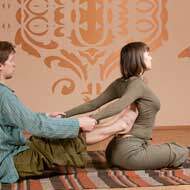Thai Yoga Massage - Ancient Therapy Answers Modern Sicknesses
Unknown to most, the ancient tradition of Thai Massage actually originated in India and not in Thailand. The founder of Thai Massage – the physician Jivaka Kumar Bhaccha – was a contemporary of the Buddha who lived in India almost 2,500 years ago.
As Buddhism spread to Thailand, the Ayurvedic traditions of India began to merge with ancient Chinese practices and Thai Massage developed. Today Thai Massage is also known as Thai Yoga Massage or Nuad Bo'Rarn meaning ‘to touch in order to heal’ and ‘that which is ancient.’
Thai Yoga massage is now gaining popularity for its health benefits and therapeutic effects.
In fact, the government of Thailand recommends the practice of Thai Yoga Massage for the treatment of common health ailments as compared to conventional medicine. Unlike other forms of massage such as Swedish massage, Thai Yoga Massage does not involve any kneading of muscles. Instead key pressure points all over the body are massaged and the body is put through a series of stretches or poses. There is no massage oil used and you are normally required to wear comfortable clothes that you can move in. You could even call Thai Yoga Massage a type of applied yoga where the massage therapist uses his or her hands, feet, arms and legs to move your body into various yoga poses or stretches. The beauty of Thai Yoga Massage is that it is not limited to only those who have done yoga before or who are ultra flexible. No matter what your age or the limits of your flexibility; Thai Yoga Massage works everyone to their individual limits in order to maximize the benefits.
Some of the benefits of Thai Yoga Massage include:
- Patients suffering from ailments such as asthma, insomnia, neck and back pain, Chronic Fatigue Syndrome, and Multiple Sclerosis have reported relief from symptoms after regular sessions of Thai Yoga Massage.
- Sportspersons and dancers benefit greatly from the stretching and yoga positions that Thai Yoga Massage uses.
- Thai Yoga Massage helps balance the flow of energy in the body and improves overall health and well-being.
- Joints become more flexible, blood circulation improves and any problems with posture and alignment of the spine are immediately addressed through Thai Yoga Massage.
If you are interested in Thai Yoga Massage, first speak to your doctor. People with any open wounds, infectious skin diseases, bruises or skin inflammation should avoid Thai Yoga Massage. Similarly, if you have recently had any type of surgery or chemotherapy or are pregnant, Thai Yoga Massage is not an option for you.
Read more articles from the Alternative Therapy and diseases Category.

 Find Pose
Find Pose

